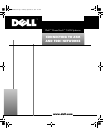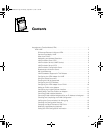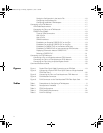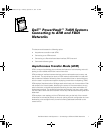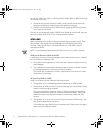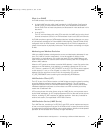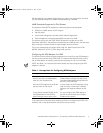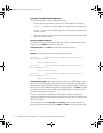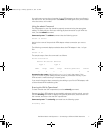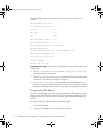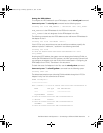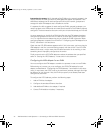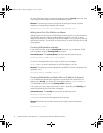
4 Dell PowerVault 7x0N Systems — Connecting to ATM and FDDI Networks
Within the LANE Service, the LES is responsible for coordinating the control func-
tions, while the LECS serves network clients by supplying ELAN configuration
information. Finally, the BUS forwards broadcast and multicast frames, and handles
unresolved unicast frames.
#"!%&
The LES performs a number of control services within an ELAN, including registering
MAC addresses and resolving these addresses to corresponding ATM addresses
when requested. LECs can also request the LES to resolve a route descriptor to an
ATM address. In either case, the LES responds to the client or forwards the request
to other clients, which might be in a better position to service the query.
The LES also coordinates the process of a LEC joining an ELAN. There is a single LES
per ELAN, and each LES has a unique ATM address.
#"!$"
The LECS maintains information concerning all the ELANs in an administrative
domain, and supplies the LEC with the ATM address for the LES in the domain.
Before joining an ELAN, the LEC first exchanges configuration information with the
LECS.
Upon successfully communicating with the LECS, the LEC receives a list of ELANs
that are available to join. There is a single LECS per administrative domain for ELANs
within a domain.
'(
The BUS accepts and processes data sent by an LEC to the broadcast MAC address
‘FFFFFFFFFFFF’. The BUS also handles all multicast messages, as well as initial uni-
cast frames sent by a LEC before the ATM address has been resolved.
The BUS thereby offers services that emulate the shared medium capabilities typical
of a LAN. The BUS does this by serializing the frames and retransmitting them to the
appropriate LECs within the ELAN.
Although there might be multiple BUSs defined within an ELAN, each LEC is associ-
ated with only a single BUS per ELAN.
'!
The UNI, which serves as an interface point between ATM end systems and the ATM
switch, supports both automatic adapter failover and load balancing across multiple
adapters connected to the same physical ATM switch. This means that the UNI signal-
ing module automatically detects which adapters are connected to a single physical
network and places all adapters connected to that network in a failover group.
With respect to load balancing, both incoming and outgoing connections are directed
to the least used adapter in a load balancing group. In cases when an adapter in a load
balancing group fails, the connections on that adapter are automatically transferred to
another adapter.
65CNPbk0.book Page 4 Monday, September 13, 1999 1:43 PM



